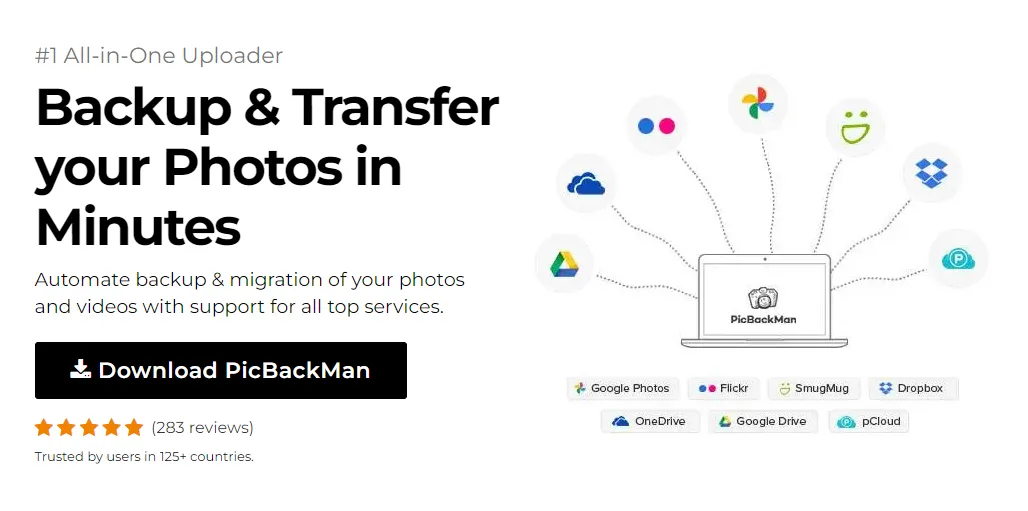Why is it the #1 bulk uploader?
- Insanely fast!
- Maintains folder structure.
- 100% automated upload.
- Supports RAW files.
- Privacy default.
How can you get started?
Download PicBackMan and start free, then upgrade to annual or lifetime plan as per your needs. Join 100,000+ users who trust PicBackMan for keeping their precious memories safe in multiple online accounts.
“Your pictures are scattered. PicBackMan helps you bring order to your digital memories.”
How to Backup SharePoint to OneDrive - 4 Easy Ways

Backing up your SharePoint data to OneDrive is a smart way to protect your important files and ensure you never lose critical information. Whether you're managing a team project or safeguarding company documents, having a reliable backup strategy is essential. In this guide, I'll walk you through four straightforward methods to backup SharePoint to OneDrive, helping you keep your data safe and accessible.
Why Backup SharePoint to OneDrive?
Before diving into the methods, let's quickly understand why backing up SharePoint to OneDrive makes sense:
- Data protection against accidental deletions or corruptions
- Easy access to important files even when SharePoint is down
- Simple file recovery without IT support
- Peace of mind knowing your work is safely stored in multiple locations
- Simplified file sharing and collaboration options
Both SharePoint and OneDrive are Microsoft products that work well together, making the backup process relatively simple. Let's explore the four easiest ways to get this done.
Method 1: Manual Download and Upload
The most basic approach is manually downloading files from SharePoint and uploading them to OneDrive. This method gives you complete control over which files get backed up.
Step-by-Step Guide for Manual Backup
Downloading from SharePoint
First, you'll need to download the files from SharePoint:
- Log into your SharePoint account
- Navigate to the document library containing files you want to backup
- Select the files or folders you want to download
- Click the "Download" button in the top menu
- Choose a temporary location on your computer to save these files
Uploading to OneDrive
Once downloaded, upload the files to OneDrive:
- Sign in to your OneDrive account
- Navigate to the folder where you want to store your backup
- Click "Upload" and select "Files" or "Folder"
- Browse to locate your downloaded SharePoint files
- Select the files and click "Open" to begin uploading
This method works well for occasional backups of specific files but becomes tedious for regular backups or large amounts of data. I recommend setting a calendar reminder if you choose this method, so you don't forget your regular backups.
Pros and Cons of Manual Backup
| Pros | Cons |
|---|---|
| No technical setup required | Time-consuming for large file collections |
| Selective backup of only important files | Requires remembering to perform backups regularly |
| Complete control over what gets backed up | Prone to human error (forgetting files) |
| No additional tools needed | No version history preservation |
Method 2: Using OneDrive Sync Client
The OneDrive sync client provides a more automated approach to backing up SharePoint files to your OneDrive account.
Setting Up OneDrive Sync Client
- Make sure the OneDrive desktop app is installed on your computer
- Log into SharePoint and navigate to the document library you want to sync
- Click the "Sync" button in the command bar
- The OneDrive sync client will launch automatically
- Confirm the location where you want to sync the files
- The SharePoint library will now sync to your computer
Transferring Synced Files to OneDrive
After syncing SharePoint files to your computer, you can set up an automated process to copy them to your OneDrive folder:
- Open File Explorer on your computer
- Locate your synced SharePoint folder (typically under "SharePoint" in the navigation pane)
- Select the files or folders you want to backup
- Copy them (Ctrl+C or right-click and select "Copy")
- Navigate to your OneDrive folder
- Paste the files (Ctrl+V or right-click and select "Paste")
For automation, you can use Windows Task Scheduler or a similar tool to create a scheduled task that copies files from your synced SharePoint folder to your OneDrive folder at regular intervals.
Advantages of Using the Sync Client
- Keeps local copies of all SharePoint files
- Updates happen automatically when files change
- Allows offline access to your SharePoint files
- Makes it easy to create automated backup scripts
- Preserves folder structure from SharePoint
Method 3: Using Microsoft Power Automate (Flow)
Microsoft Power Automate (formerly known as Flow) offers a no-code solution for creating automated workflows between SharePoint and OneDrive.
Creating a Power Automate Flow
Basic Flow Setup
- Go to flow.microsoft.com and sign in with your Microsoft account
- Click "Create" and select "Automated flow"
- Give your flow a name (e.g., "SharePoint to OneDrive Backup")
- Choose a trigger - for example, "When a file is created or modified (properties only)" in SharePoint
- Click "Create"
Configuring the Flow Steps
- In the trigger, select your SharePoint site and library
- Add a new step by clicking "+ New step"
- Search for "Get file content" and select the SharePoint connector
- Configure it to get the content of the file that triggered the flow
- Add another step and search for "Create file" under OneDrive
- Configure it to create a file in your OneDrive using the content from the previous step
- Set the folder path in OneDrive where you want to save the backup
- Use the filename from the SharePoint file for consistency
- Save your flow
Advanced Flow Options
You can enhance your Power Automate flow with additional features:
- Schedule regular backups of entire libraries using a recurrence trigger
- Add conditions to only backup specific file types
- Create a naming convention that includes the backup date
- Set up email notifications when backups complete
- Add error handling to manage failed transfers
Power Automate is particularly useful because it runs in the cloud, so your computer doesn't need to be turned on for the backup to happen.
Sample Flow for Scheduled Backup
Here's a simple example of a scheduled backup flow:
- Trigger: Recurrence (set to daily, weekly, or your preferred schedule)
- Action: Get files (properties only) from SharePoint library
- Apply to each file from the previous step:
- Get file content using the ID from the previous step
- Create file in OneDrive with the content
- Optional: Send an email notification when complete
Method 4: Using Third-Party Backup Tools
If you need more robust backup options, third-party tools can provide advanced features for backing up SharePoint to OneDrive.
Popular Third-Party Backup Solutions
AvePoint Cloud Backup
AvePoint offers comprehensive backup solutions for Microsoft 365, including SharePoint to OneDrive transfers:
- Automated, incremental backups
- Point-in-time restoration
- Granular recovery options
- Retention policy management
- Detailed reporting and monitoring
Veeam Backup for Microsoft 365
Veeam provides reliable backup and recovery tools:
- Flexible backup scheduling
- End-user self-service recovery portal
- Data protection across SharePoint, OneDrive, and other Microsoft 365 services
- Easy-to-use search functionality
- Comprehensive audit logs
SysTools Office 365 Backup & Restore
A simpler solution that works well for small to medium businesses:
- One-time and scheduled backups
- Selective or complete backup options
- Preserves metadata and permissions
- Simple user interface
- Affordable pricing for smaller organizations
Setting Up a Third-Party Tool
While each tool has its specific setup process, here's a general approach:
- Sign up for or purchase your chosen backup solution
- Install the software (if required) or set up the cloud service
- Connect the tool to your Microsoft 365 account with admin credentials
- Select SharePoint as your source and OneDrive as your destination
- Configure backup schedules, retention policies, and notification settings
- Run an initial backup and verify the results
- Monitor subsequent backups through the tool's dashboard
Comparing Third-Party Backup Tools
| Tool | Best For | Price Range | Ease of Use |
|---|---|---|---|
| AvePoint Cloud Backup | Large enterprises with complex needs | High (contact for quote) | Moderate - requires some technical knowledge |
| Veeam Backup | Medium to large businesses | Medium to High | Moderate - IT assistance recommended |
| SysTools Office 365 Backup | Small businesses and individuals | Low to Medium | Easy - minimal setup required |
Best Practices for SharePoint to OneDrive Backups
No matter which method you choose, following these best practices will help ensure your backups are effective:
Organizing Your Backup Structure
- Create a dedicated backup folder in OneDrive with a clear name (e.g., "SharePoint Backups")
- Organize backups by site, library, or department
- Use consistent naming conventions that include dates (YYYY-MM-DD format works well)
- Consider creating separate folders for different backup frequencies (daily, weekly, monthly)
Setting Up a Backup Schedule
Determine how often to back up based on how frequently your SharePoint content changes:
- Critical business documents: Daily backups
- Frequently updated project files: 2-3 times per week
- Reference materials that rarely change: Monthly backups
- Consider incremental backups for large libraries (only backing up what's changed)
Managing Backup Storage Space
OneDrive has storage limits, so manage your space wisely:
- Regularly clean up old or redundant backups
- Implement a retention policy (e.g., keep daily backups for 2 weeks, weekly for 2 months)
- Consider compressing large backups to save space
- Monitor your OneDrive storage usage to avoid hitting limits
- Upgrade your storage plan if needed for comprehensive backups
Testing Your Backup and Recovery Process
A backup is only as good as your ability to restore from it:
- Schedule regular test restores to verify backup integrity
- Document your restoration process step by step
- Time how long restores take to set realistic expectations
- Train multiple team members on the restore process
- Keep backup documentation updated as your process evolves
Troubleshooting Common Backup Issues
Even with the best setup, you might encounter some challenges:
Handling Large Files and Libraries
Very large SharePoint libraries can be challenging to back up:
- Break up large backups into smaller batches
- Use incremental backups to reduce transfer sizes
- Schedule backups during off-hours to minimize impact
- Consider excluding non-essential files (like old versions or temporary files)
- For files over 100GB, specialized enterprise backup tools may be required
Dealing with Permission Issues
Permission problems can block successful backups:
- Ensure your account has sufficient permissions for both SharePoint and OneDrive
- For automated methods, use an admin account or service account
- Check for any conditional access policies that might restrict access
- Verify that multi-factor authentication isn't interrupting automated processes
- Review SharePoint sharing settings that might limit access
Resolving Sync Conflicts
When using sync methods, conflicts can occur:
- Set clear file naming conventions to avoid duplicates
- Implement a process for handling conflicted copies
- Consider using version history rather than multiple file copies
- Establish who has authority to resolve conflicts
- Document your conflict resolution process for team reference
Comparing the 4 Backup Methods
Let's compare all four methods to help you choose the right one for your needs:
| Method | Ease of Setup | Automation Level | Cost | Best For |
|---|---|---|---|---|
| Manual Download/Upload | Very Easy | None | Free | Occasional backups of few files |
| OneDrive Sync Client | Easy | Medium | Free | Regular backups of moderate size |
| Power Automate | Moderate | High | Free/Low* | Regular automated backups |
| Third-Party Tools | Complex | Very High | Medium/High | Enterprise-level backup needs |
*Power Automate is free for basic flows but may require premium connectors for advanced features.
Which Method Should You Choose?
- For individuals or small teams: Manual method or OneDrive Sync Client is usually sufficient
- For medium-sized teams with regular backup needs: Power Automate offers a good balance of features and simplicity
- For large organizations with critical data: Third-party backup tools provide the most comprehensive protection
- For technical users comfortable with automation: Power Automate offers the best value
- For non-technical users: OneDrive Sync Client is the most user-friendly option
Security Considerations for SharePoint Backups
When backing up data, security should always be a priority:
Protecting Sensitive Data
- Be mindful of confidential information in your backups
- Consider encrypting highly sensitive backups
- Review who has access to your OneDrive backup folders
- Use secure sharing settings for backup folders
- Consider creating a separate OneDrive account specifically for backups
Compliance and Regulatory Requirements
If your organization is subject to regulations:
- Verify that your backup method meets compliance requirements
- Document your backup procedures for audit purposes
- Ensure retention policies align with regulatory mandates
- Consider geographic storage restrictions for certain types of data
- Maintain logs of backup activities for compliance reporting
Multi-Factor Authentication Considerations
While MFA enhances security, it can impact automated backups:
- For automated methods, create app passwords or use service accounts
- Ensure backup processes can function with MFA enabled
- Test backup solutions thoroughly after implementing MFA
- Document any special authentication steps in your backup procedures
Quick Tip to ensure your videos never go missing
Videos are precious memories and all of us never want to lose them to hard disk crashes or missing drives. PicBackMan is the easiest and simplest way to keep your videos safely backed up in one or more online accounts.
Simply download PicBackMan (it's free!), register your account, connect to your online store and tell PicBackMan where your videos are - PicBackMan does the rest, automatically. It bulk uploads all videos and keeps looking for new ones and uploads those too. You don't have to ever touch it.
Conclusion
Backing up SharePoint to OneDrive doesn't have to be complicated. Whether you choose the simple manual approach, the convenient sync client, the automated Power Automate solution, or a comprehensive third-party tool, the important thing is having a reliable backup system in place.
Start with the method that best matches your technical comfort level and backup needs. You can always upgrade to a more sophisticated approach as your requirements evolve. The peace of mind that comes from knowing your critical SharePoint data is safely backed up to OneDrive is well worth the effort of setting up a backup system.
Remember to test your backups regularly, maintain good organization of your backup files, and keep your backup process documented. With these practices in place, you'll be well-prepared to recover quickly from any data loss situation.
Frequently Asked Questions
1. How often should I backup my SharePoint files to OneDrive?
The frequency depends on how often your data changes and how critical it is. For important business documents that change frequently, daily backups are recommended. For less critical or rarely changed files, weekly or monthly backups may be sufficient. Consider your organization's recovery point objective (how much data you can afford to lose) when determining backup frequency.
2. Will backing up SharePoint to OneDrive preserve all metadata and permissions?
Basic methods like manual download/upload or the sync client typically don't preserve all metadata and permissions. Power Automate can be configured to maintain some metadata, but for complete preservation of permissions, version history, and all metadata, a third-party backup solution specifically designed for SharePoint is usually necessary.
3. Can I automate SharePoint to OneDrive backups without any coding knowledge?
Yes! Microsoft Power Automate (Flow) is designed for non-programmers and uses a visual interface to create automated workflows. You can create a flow that backs up SharePoint files to OneDrive without writing any code. The OneDrive sync client also provides some automation without requiring coding skills.
4. Is OneDrive secure enough for backing up confidential SharePoint documents?
OneDrive for Business uses the same security measures as SharePoint, including encryption at rest and in transit. However, you should still be mindful of sharing settings and access permissions for your backup folders. For highly sensitive data subject to strict regulatory requirements, you might want to consider enterprise-grade backup solutions with additional security features.
5. What's the maximum file size I can backup from SharePoint to OneDrive?
OneDrive for Business supports files up to 250 GB in size, which matches SharePoint's limit. However, very large files may take significant time to transfer, especially with manual methods. For files approaching these limits, consider using the sync client or a third-party tool that supports efficient handling of large files and can resume interrupted transfers.






